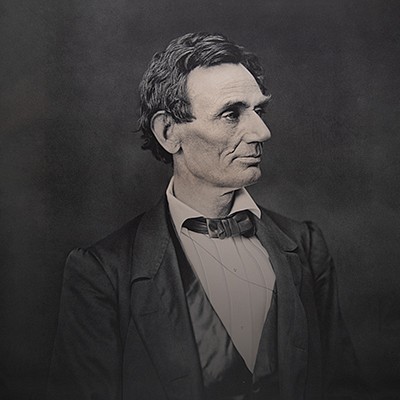President Abraham Lincoln Signed Document, Dating to His Issuance of General War Order No. 1 and the Advancement of All Land and Sea Forces
Two ways to bid:
- Leave a max absentee bid and the platform will bid on your behalf up to your maximum bid during the live auction.
- Bid live during the auction and your bids will be submitted real-time to the auctioneer.
Bid Increments
| Price | Bid Increment |
|---|---|
| $0 | $5 |
| $50 | $10 |
| $200 | $25 |
| $500 | $50 |
About Auction
Feb 14, 2024
RR Auction's February Fine Autographs and Artifacts auction boasts 600 unique items, and honors Presidents' Day with a special section featuring incredible presidential autographs, artifacts, and memorabilia. RR Auction support@rrauction.com
- Lot Description
Civil War-dated partly-printed vellum DS as president, one page, 13.5 x 17.5, February 27, 1862. President Lincoln appoints Silas Crispin as a “Captain in the Ordnance Department.” Signed neatly at the conclusion by President Abraham Lincoln and countersigned by Secretary of War Edwin M. Stanton. The blue War Department seal remains affixed to the upper left portion. The document is affixed to a backing board and attractively gilt-framed to a slightly larger size. In fine condition, with scattered light soiling, and possible mounting (not examined out of the frame); Lincoln's signature is dark, clear, and distinct.
This commission dates to a significant and somber period of Lincoln’s presidency. On January 20, 1862, he restructured the War Department, deemed ‘the lunatic asylum,’ by appointing Edwin M. Stanton as the new Secretary of War. Then, four days later, Lincoln and his wife attended the funeral service for their 11-year-old son, Willie, in the East Room of the Executive Mansion. The death of Willie was especially hard on the first lady, who, per Elizabeth Keckley, Mary Todd’s personal dressmaker and confidante, ‘was an altered woman...she never crossed the threshold of the Guest's Room in which he died, or the Green Room in which he was embalmed.’
On the day of this appointment, January 27, 1962, Lincoln issued General War Order No. 1, ordering all land and sea forces to advance on February 22, 1862. This order, written and signed by Lincoln without consulting any advisors, was without precedent. It was designed to celebrate Washington’s birthday, disrupt the upcoming Confederate inaugural ceremonies, and force General-in-Chief George B. McClellan to move. The order reflected the frustration both Lincoln and Stanton had with McClellan’s reluctance to divulge his plans. True to form, McClellan ignored this order, and four days later, Lincoln followed this up with the President’s Special War Order Number 1, which was specifically aimed at forcing McClellan to begin offensive operations in Virginia.
When McClellan received this order, he rushed to the White House and objected to an overland advance with a 22-page proposal to move the Potomac army by water down the Virginia coast and land at Urbanna. A back-and-forth ensued before Lincoln reluctantly agreed. He had finally got McClellan to divulge his plans. But that was the only tangible result that came from his two orders because, for the most part, the Federal armies in the field remained stationary. On March 11, 1862, Lincoln removed McClellan as general-in-chief, leaving him in command of only the Army of the Potomac.
Silas Crispin (1828-1889) graduated with distinction, being third in his class, from the U. S. Military Academy at West Point on July 1, 1850, and was then appointed a Brevet Second Lieutenant in the Ordnance Department, U. S. Army. He was promoted from time to time, finally attaining the rank of Colonel of Ordnance on August 23, 1881. During the Civil War, Colonel Crispin served on the staff of Major-General George B. McClellan, and was also in charge of the New York Ordnance Agency as a member and later president of the Ordnance Board. - Shipping Info
-
Bidder is liable for shipping and handling and providing accurate information as to shipping or delivery locations and arranging for such. RR Auction is unable to combine purchases from other auctions or affiliates into one package for shipping purposes. Lots won will be shipped in a commercially reasonable time after payment in good funds for the merchandise and the shipping fees are received or credit extended, except when third-party shipment occurs. Bidder agrees that service and handling charges related to shipping items which are not pre-paid may be charged to a credit card on file with RR Auction. Successful international Bidders shall provide written shipping instructions, including specified Customs declarations, to RR Auction for any lots to be delivered outside of the United States. NOTE: Declaration value shall be the item’(s) hammer price and RR Auction shall use the correct harmonized code for the lot. Domestic Bidders on lots designated for third-party shipment must designate the common carrier, accept risk of loss, and prepay shipping costs.
-
- Buyer's Premium



 EUR
EUR CAD
CAD AUD
AUD GBP
GBP MXN
MXN HKD
HKD CNY
CNY MYR
MYR SEK
SEK SGD
SGD CHF
CHF THB
THB





